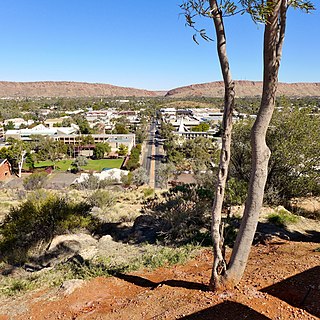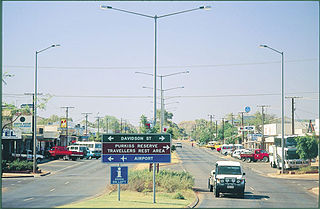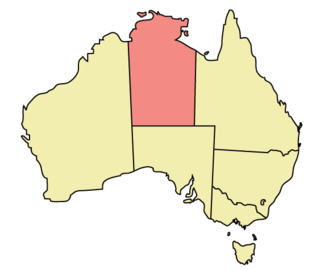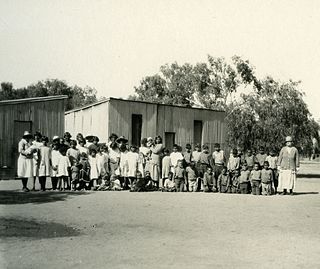Related Research Articles

Alice Springs is the third-largest town in the Northern Territory of Australia. Known as Stuart until 31 August 1933, the name Alice Springs was given by surveyor William Whitfield Mills after Alice, Lady Todd, wife of the telegraph pioneer Sir Charles Todd. Now colloquially known as The Alice or simply Alice, the town is situated roughly in Australia's geographic centre. It is nearly equidistant from Adelaide and Darwin.

Albert Namatjira was an Aboriginal artist from the MacDonnell Ranges in Central Australia. As a pioneer of contemporary Indigenous Australian art, he was the most famous Indigenous Australian of his generation.

Tennant Creek is a town located in the Northern Territory of Australia. It is the seventh largest town in the Northern Territory, and is located on the Stuart Highway, just south of the intersection with the western terminus of the Barkly Highway. At the 2016 census, Tennant Creek had a population of approximately 3,000, of which more than 50% (1,536) identified themselves as indigenous.

Kintore is a remote settlement in the Kintore Range of the Northern Territory of Australia about 530 km (330 mi) west of Alice Springs and 40 km (25 mi) from the border with Western Australia. At the 2016 census, Kintore had a population of 410, of which 376 identified themselves as Aboriginal Australians.

Vincent Lingiari AM was an Australian Aboriginal rights activist and member of the Gurindji people. In his early life he started as a stockman at Wave Hill Station, where the Aboriginal workers were given no more than rations, tobacco and clothing as their payment. After the owners of the station refused to improve pay and working conditions at the cattle station and hand back some of Gurindji land, Lingiari was elected and became the leader of the workers in August 1966. He led his people in the Wave Hill walk-off, also known as the Gurindji strike.

Papunya is a small Indigenous Australian community roughly 240 kilometres (150 mi) northwest of Alice Springs (Mparntwe) in the Northern Territory, Australia. It is known as an important centre for Contemporary Indigenous Australian art, in particular the style created by the Papunya Tula artists in the 1970s, referred to colloquially as dot painting. Its population in 2016 was 404.

Yuendumu is a town in the Northern Territory of Australia, 293 kilometres (182 mi) northwest of Alice Springs on the Tanami Road, within the Central Desert Region local government area. It ranks as one of the larger remote communities in central Australia, and has a thriving community of Aboriginal artists. It is home to Pintubi Anmatjere Warlpiri (PAW) Media, which produced the TV series Bush Mechanics.

Crime in the Northern Territory is managed by the Northern Territory Police, the territory government's Department of the Attorney-General and Justice and Territory Families.

Ti-Tree is a town and locality in the Northern Territory of Australia located on the Stuart Highway about 1,109 kilometres (689 mi) south of the territory capital of Darwin and about 193 km north of the municipal seat in Alice Springs.

Aṉangu Pitjantjatjara Yankunytjatjara, also known as APY, APY Lands or the Lands, is a large, sparsely-populated local government area (LGA) for Aboriginal people, located in the remote north west of South Australia. Some of the aṉangu (people) of the Western Desert cultural bloc, in particular Pitjantjatjara, Yankunytjatjara and Ngaanyatjarra peoples, inhabit the Lands.

Titjikala is an Aboriginal community in the south of the Northern Territory of Australia. At the 2011 census, Titjikala had a population of 201.
Nora Andy Napaltjarri is a Warlpiri- and Luritja-speaking Indigenous artist from Australia's Western Desert region. like her mother Entalura Nangala, Nora has painted for Indigenous artists' cooperative Papunya Tula. Her work has been exhibited at the Gauguin Museum in Tahiti, and is held by Artbank.
Molly Jugadai Napaltjarri (c.1954–2011) was a Pintupi- and Luritja-speaking Aboriginal artist from Australia's Western Desert region. Her paintings are held in major collections, including the National Gallery of Australia.

The Bungalow was an institution for Aboriginal children established in 1914 in Alice Springs in the Northern Territory of Australia. It existed at several locations in Alice Springs, Jay Creek and the Alice Springs Telegraph Station.
Margaret Heffernan, is a Central Arrernte linguist, author, interpreter and translator who is now a well respected elder in her community. Heffernan is responsible for developing the orthography of Arrernte.
Geoff Shaw is an Aboriginal ex-serviceman from Central Australia and an Aboriginal leader in Alice Springs who has been involved in many Aboriginal organisations
Sally M. Nangala Mulda is an Arrernte and Southern Luritja artist who lives and works in Alice Springs. She paints for Tangentyere Artists.

Tangentyere Council, formerly known as Tunkatjira, is a major service delivery agency in Alice Springs which offers a wide range of services and programs for Aboriginal people in Central Australia. First established in the 1970s, it has grown beyond its original purpose, which was to support and provide tenure, services and essential services for Alice Springs Town Camps and their residents, to incorporate family, community and social services, as well as running a number of not-for-profit enterprises.
Little Flower Mission operated from 1938 - 1942 and it was a mission to Eastern Arrernte people who were living in and around the township of Alice Springs. The mission was established by Catholic missionaries, part of the Missionaries of the Sacred Heart order.
Shirleen Campbell is a Warlpiri, Anmatyerre, Luritja and Arrernte family and domestic violence activist from Mparntwe in the Northern Territory of Australia.
References
- ↑ "Alice Springs Town Camps". Office of Township Leasing. 11 July 2017. Retrieved 13 November 2019.
- ↑ Government, Northern Territory (13 April 2018). "Frequently asked questions". dlghcd.nt.gov.au. Retrieved 13 November 2019.
- ↑ "Heritage & History Of The Alice Springs Telegraph Station". Alice Springs Telegraph Station. Retrieved 13 November 2019.
- 1 2 3 Coughlan, Frances Mary (1991). Aboriginal town camps and Tangentyere Council : the battle for self-determination in Alice Springs (Thesis thesis).
- ↑ "A colonial chronology of Alice Springs | Central Land Council, Australia". www.clc.org.au. Retrieved 13 November 2019.
- 1 2 "Tangentyere Council - About Us". www.tangentyere.org.au. Retrieved 13 November 2019.
- ↑ "Shirleen Campbell". Australian of the Year Awards. Retrieved 10 July 2021.
- ↑ "Capricornia Film Awards Announce Award Winners". FilmInk. Retrieved 10 July 2021.
- ↑ "Artists | The National". www.the-national.com.au. Retrieved 6 January 2021.
- ↑ "Artist Profile: Sally M Nangala Mulda". Art Edit Magazine. 30 May 2019. Retrieved 6 January 2021.
- ↑ Kleinert, Sylvia, "Cultural Advice", Australian Dictionary of Biography, Canberra: National Centre of Biography, Australian National University, retrieved 6 January 2021
- ↑ admin. "Resurgence in the 1960s and 1970s". The Hermannsburg School of Modern Art. Retrieved 6 January 2021.
- ↑ "Tangentyere Council, Alice Springs". www.tangentyere.org.au. Retrieved 6 January 2021.
- ↑ "'When will they listen to us?' Town camps on the fringe of Alice, but at the heart of Indigenous debate". the Guardian. 22 September 2015. Retrieved 6 January 2021.